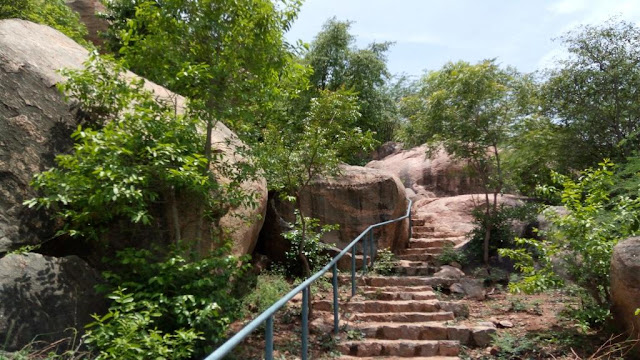Jain Cave Temple Complex, Yanaimalai, Madurai
Jain
Cave Temple Complex is Jain religious complex consisting of Jain Cavern and Jain
Sculptural Cave Temple located in Yanaimalai Hill in Madurai District of
Tamilnadu. Yanaimalai (Elephant Hill) is a protected monument and tourist attraction in Tamil
Nadu. The hill stretches over 3 Kms (1.9 mi) and
is 90 metres (300 ft) high. It has Jain sculptures, a Shaivite Temple, Ladan
Cave Temple, and a Vaishnavite temple, namely the Narasingam Yoga Narasimha
Perumal Temple. The hill is of rich in granite, and has been damaged by illegal quarrying. In
2010, the government of Tamil Nadu tried to set up a sculpture
garden on the hill, but backed out
after locals and activists protested against the idea.
Etymology
The hill
derives its name from the Tamil word Yanai, meaning "elephant",
and malai, meaning "hill". The hill looks like an elephant in a
sitting position. The site has had this name for over 2000 years.
Legends
The Thiruvilayadal Purana, written by Perumbatta Puliyur Nambi and later amended
by Paranjothi Munivar, says that the Chola king, who could not win the battle against the
Pandya ruler, sought the help of Jains. They created a giant elephant using their mystic
powers and directed it to kill the Pandya king and destroy his capital. But the
Pandya prayed to Lord Siva to save him and his capital. The Lord sent to him
the "Narasinga Asthram" (the eight-lettered word Namo Narayana), which
turned the elephant into a hill. To commemorate this event, a stone elephant
was installed in Madurai near the Vaigai facing the north, which is found near the
Yanaikkal bridge even today.
History
Yanaimalai
is considered a sacred place by the Tamil
Jain. Jain monks lived here during the Pandyan
Dynasty. Yanaimalai has been historically
important with its historical monuments and other sources of cultural ethos
since the Sangam age, which is about one thousand and eight hundred years old.
This hill is fondly called by the people as Yanaimalai (elephant hill), from
very early period, as it looks like an elephant. The hill is the historical
source as it has early caves with epigraphical records and sculptures and
inscriptions of the Early Pandya, Later Pandya, Chola and Vijayanagar – Nayak
rulers.
The top
of the hill has Tamil Brahmi inscriptions of the 1st century A.D. This historic
hill was sung by one of the three great Saiva Nayanmars, Tirugnanasambandar, as
the dwelling place of the Jains. Paranjothimuni, in his Thiruvilayadal purana,
mentions that this hill was originally an elephant incited by the Jains to
destroy Madurai. When Lord Siva threw an arrow at it, it became a stone
elephant and thus is called Yanaimalai. The Jains believe that the Saints who
authored one of the Sangam classics, Naladiyar, lived in this hill.
The
Jains reverentially consider Yanaimalai as one of the eight Jain centers
located around Madurai. Though the Jains, Vaishnavites and Saivites were
competing each other to promote their respective religions in this region, in
due course, they seem to have maintained toleration to each other. This is
evident from the records available at Yanaimalai. It has the credit of
accommodating the historical monuments from Shaivism, Vaishnavism and Jainism.
Jain Cave
Temple Complex
Jain
Cave Temple Complex consists of two parts namely; Natural Jain Cavern and Jain
Sculptural Cave.
Natural Jain Cavern (1st century A.D):
There is
a natural cavern of the Jains located at the top of the hill’s southern side
(Nose of the hill). It was established in the 1st century A.D. for
the dwelling of the Jain monks. A Tamil Brahmi inscription of this period found
here mentions that it was set up along with rock beds by one Eri Aarithan
Aththuvayi Arattakasibhan and it was called as “Ivakundram”. There are also
stone beds used by the monks for resting. Tamil-Brahmi and Vatteluthu inscriptions can be found on
the hill.
Jain Sculptural Cave (9th - 10th
Century A.D.):
The
bas-relief sculptural panels of the Jain Thirthankaras, Yakshi and Yaksha are
seen at the façade of a natural cavern located on the western side of the hill
at a medium height. They belong to the 9th - 10th century
A.D. The names of the donors of these sculptures are engraved in Vatteluthu
script under the images. These sculptures also show early paintings on them. At
the top of the hill can be found caves containing Jain bas
relief sculptures of Mahavira, Gomateshwara, and other Tirthankaras fashioned by Jain monks. An individual Thirthankar
statue worshipped as “Lord Muniyandi” by the local people.
Connectivity
The Jain
Cave Temple Complex is located at about 2 Kms from Othakadai Bus Stop, 6 Kms
from Thirumohur, 6 Kms from Thirumohoor Kala Megha Perumal Temple, 10 Kms from Madurai,
12 Kms from Madurai Periyar Bus Stand, 5 Kms from Mattuthavani Integrated Bus
Terminus, 12 Kms from Madurai Railway Junction, 11 Kms from Madurai Meenakshi
Amman Temple and 22 Kms from Madurai International Airport. The Jain Cave
Temple Complex is situated on Madurai to Melur Road. At the Othakadai Junction
take a left and reach the temple. The Hill is visible from all around. Take a
mini bus from Mattuthavani (Madurai Central Bus Stand) bus terminus to
Othakadai. Take an auto-rickshaw from Mattuthavani Bus terminus or Madurai
Central Railway Station to Othakadai. Mini buses are available for every 10
minutes from Othakadai.










